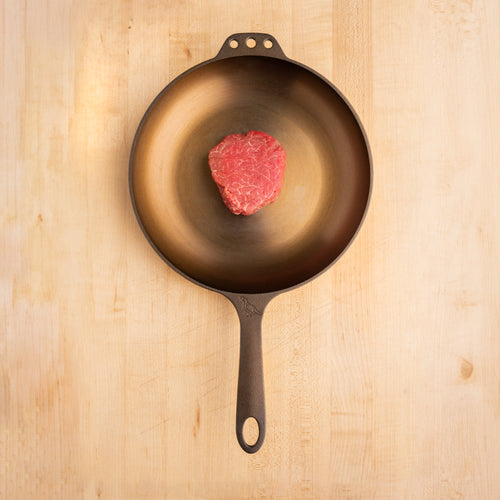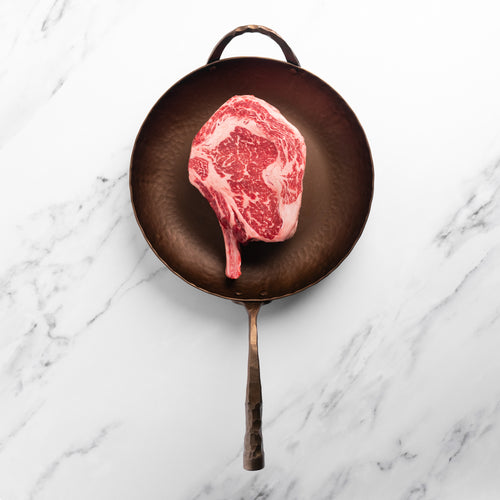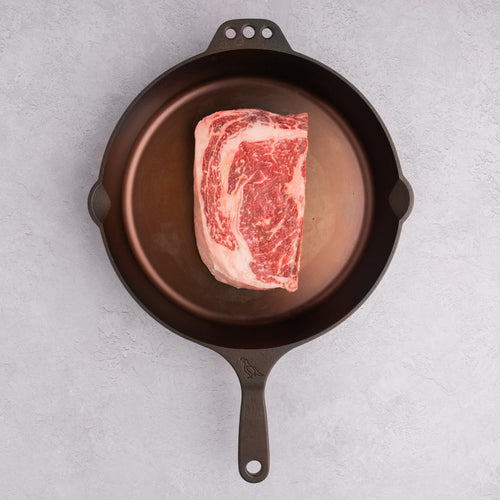
SRF Steaks – Cut to Thickness, Not by Weight
When it comes to steak, weight is only part of the equation—thickness is what truly defines quality. At Snake River Farms, we know the best steak thickness ensures the perfect sear, tenderness, and flavor. That’s why our master butchers cut steaks to precise thickness, not just weight. With expert craftsmanship, we guarantee every cut meets our high standards, so you can enjoy a steak that’s consistently exceptional.
|
Table of Contents |
Why Steak Thickness Matters
When buying steak at the store, most people are familiar with shopping by weight. Weight is a simple way to determine the quality of a steak. Grocery stores advertise the price per pound and restaurant menus shout out the size of a cut. Obviously, weight is meaningful, but of equal importance is a steak's thickness.
A steak cut at least 1.5” thick has many benefits. It provides sufficient size to sear each side over high heat and allow the interior to remain pink and juicy. Thin steaks are easily overcooked in the middle after searing both sides. This means anyone who enjoys a steak cooked rare to medium rare must look to larger cuts to achieve their preferred finish.
Aesthetics also play a significant role in the appeal of a thick cut steak. A substantial steak looks appetizing on the plate and makes a statement when you showcase it on your dinner table.
The Best Thickness for Steak
So, what’s the ideal thickness for a steak? Our master butchers at Snake River Farms recommend:
- 1 - 1.5 inches for traditional cuts like ribeyes and New York strips.
- 2 inches for filet mignons and ribeye filets.
- 3 inches for larger cuts like cowboy steaks and tomahawks.
This approach ensures an optimal balance of texture, flavor, and presentation.
Thick vs Thin: Understanding the Difference
If a thick steak is desirable, why are steaks often cut thin? One reason is simple economics. A thin cut allows online sellers and grocery stores to produce more steaks at a price that’s lower and more attractive to the average shopper.
It's important to note that a larger weight does not automatically translate to a thick cut steak. Many butchers focus on a weight range. Following this approach produces steaks of varying thickness.
Steaks are cut from sections of beef, called subprimals, that are not consistently sized. Subprimals may appear uniform, but they frequently taper from end to end. Cutting steaks of equal weight creates thinner ones on the wide end and thicker ones on the narrow end. Additionally, weight based cuts create inconsistencies. Since subprimals naturally taper, steaks cut to a specific weight will vary in thickness, leading to unpredictable cooking results.
How Snake River Farms Cuts Steaks
To ensure consistency, we cut our steaks by thickness rather than weight. This method guarantees:
- Uniformity in size, making cooking easier.
- A better balance of seared crust and juicy center.
- A premium presentation worthy of a top-tier steak.
For example, when you purchase an American Wagyu Gold Grade Ribeye 1.5”, you know exactly what you’re getting. This level of precision is what sets our steaks apart.
Best Steak Thickness for Different Cuts
At Snake River Farms, we cut our steaks by thickness to ensure consistency and superior cooking results.
Here’s how our thickness specifications break down:
Ribeye & New York Strip
- 1-inch – A great option for quicker cooking methods like pan-searing and broiling.
- 1.5-inch – Our standard cut, perfect for achieving a rich sear while maintaining a juicy center.


Filet Mignon & Ribeye Filet
- 2-inch – Provides a thick, tender bite with a beautiful balance of crust and interior doneness. Sold by weight in 6, 8, and 10 oz. portions.

Cowboy Steak & Tomahawk
- Over 2-inches– These bone-in cuts are designed for an impressive presentation and deep, beefy flavor. Thickness may vary slightly due to natural differences in rib bone size.


Why We Cut by Thickness, Not Weight
Steaks come from subprimals, which naturally taper in size. If steaks were cut strictly by weight, some would end up too thin while others too thick. By focusing on thickness first, we ensure a consistent experience every time you cook.
The ideal Thickness for Different Cooking Methods
Cooking techniques should complement the thickness of your steak. Here’s how to get the best results:
Grilling (Best for 1.5-inch to 3-inch steaks)
- Use the reverse-sear method for thicker cuts.
- Start with indirect heat, then finish with a high-heat sear.
- Rest the steak before slicing to retain juices.
Pan-Searing (Ideal for 1.5-inch steaks)
- Preheat a heavy skillet to high heat.
- Sear each side for a deep crust, then finish in the oven if needed.
- Use butter, garlic, and fresh herbs to enhance flavor.
Steakhouse Method (Great for 1.5-inch to 3-inch steaks)
- Sear the steak in a hot cast-iron skillet.
- Transfer to a preheated oven to finish cooking.
- Baste with butter, herbs, and garlic for extra richness.
Oven Roasting (Best for large cuts like tomahawks and cowboy steaks)
- Preheat the oven to a low temperature (275°F to 300°F).
- Roast until the internal temperature is 10°F below your target doneness.
- Sear in a hot pan or on the grill for a perfect crust.
Tips for Cooking Thin Steaks
If you’re working with a steak that’s less than 1.5 inches thick, follow these tips:
- Use high heat and a quick sear to avoid overcooking.
- Avoid excessive flipping—one or two turns is enough.
- Rest the steak briefly to prevent moisture loss.
Tips for Cooking Extra-Thick Steaks
For steaks over 2 inches thick, use these methods to achieve the perfect doneness:
- Reverse Sear: Slowly cook at low heat in the oven or on indirect grill heat, then finish with a high-heat sear for a crisp crust.
- Sous Vide: Cook in a precisely controlled water bath, then sear for a perfect edge-to-edge finish.
- Steakhouse Method: Sear the steak in a hot cast-iron skillet, then transfer to a preheated oven to finish cooking evenly.
- Oven Roasting: For ultra-thick cuts like tomahawks, roast at a lower temperature (275°F to 300°F) until the internal temp is just below your target, then sear for a rich crust.
- Use a Meat Thermometer: Thicker steaks take longer to cook, so an instant-read thermometer ensures perfect doneness.
Pulling Our Weight with Thick Cut Steak
At We take pride in providing exceptional steaks to our customers. Many factors make Snake River Farms steaks superior from other sources. These include our carefully managed rearing of American Wagyu cattle and supervision of every detail from ranch to table.
While there are many reasons our steaks taste so good, we recommend trying any of our thick cuts to experience first-hand the enjoyment that only comes from a full sized ribeye, New York or filet mignon.
At Snake River Farms, we take pride in providing exceptional steaks to our customers. Many factors make our steaks superior to others, including our carefully managed rearing of American Wagyu cattle and supervision of every detail from ranch to table.
While there are many reasons our steaks taste so good, we recommend trying any of our thick cuts to experience first-hand the enjoyment that only comes from a full-sized ribeye, New York, or filet mignon. Discover the perfect steak thickness for an unforgettable meal—shop our selection today!

Author Bio
Dave Yasuda has worked with Snake River Farms for over 12 years, cooking virtually every product we sell. He has prepared SRF products for photoshoots, food festivals, company events, and customers. A skilled home cook, Dave has collaborated in the kitchen with award-winning chefs, recipe developers, and content creators to enhance his culinary skills. He has also been a featured guest on numerous food-centric podcasts, including Bon Appetit’s “Dinner SOS” hosted by Chris Morocco.







